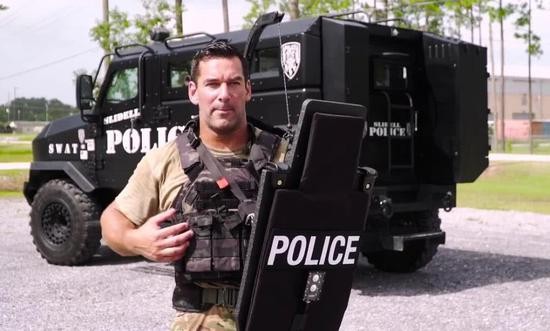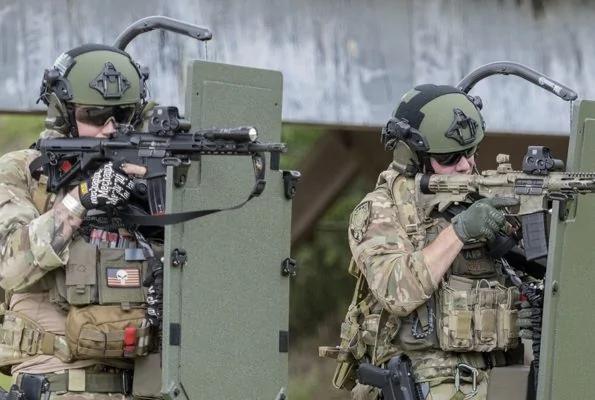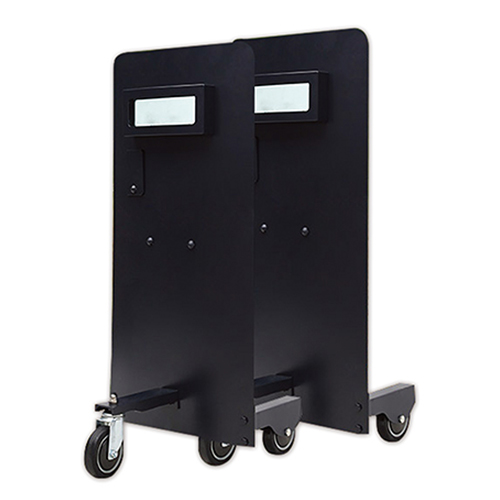Background
Shields small enough to be carried by a single person may be termed "personal shields", and may be carried in police cars in the United States as standard equipment. Whether or not a shield is used will depend on both policy and the individual situation. It may be the policy of a police force to use shields only in defensive situations, such as establishing a perimeter and waiting for reinforcements, while others may permit their usage in offensive situations, such as vehicle stops that are considered high risk or approaching a suspect deemed to be dangerous.

Recommended features of ballistic shields for police include a carrying system that allows it to be held long-term without fatigue, and the ability to both reload a handgun while holding the shield and also fire it accurately with one hand. The carriage of a ballistic shield in one hand will limit both the types of firearms that can be used with the other hand as well as certain methods of shooting.
Composition
Ballistic shields are similar to body armor plates in their construction, and are typically made out of fibre-reinforced plastic composites derived from ultra-high-molecular-weight polyethylene or aramid. [3] They may, like ceramic armor, incorporate a ceramic layer on their outer surface to enable them to defeat steel-core armor-piercing bullets. They may have features such as transparent armor windows, ambidextrous handles, and spotlights for use at night, and may be either hand-held or mounted on wheeled frames. They vary in size, with some being designed to protect only the upper torso and others designed to protect the whole body. [1] Unlike a ballistic vest, projectiles successfully stopped by a ballistic shield will not transfer trauma or pain to the bearer, as they are designed to not be in direct contact with the body.
There are many materials that can be used to make bulletproof shields, including Kevlar, polyethylene, ceramics and steel plates.
Bulletproof shields are generally classified by size and can be divided into ultra-small (450mm × 650mm), small (550mm × 650mm), medium (550mm × 1000mm), large (600mm × 1300mm) and super-large (600mm × 1750mm). Bulletproof shields also have strict protection standards. The National Institute of Justice of the United States has set 7 levels of bulletproof shields - Level I, Level IIA, Level II, Level IIIA, Level III, Level IV and Special class. Level I can protect against 0.22-inch pistol and 0.38-inch special pistols; Level IIA can protect against 0.357-inch Magnum and 9mm pistols (lower muzzle velocity types, such as 0.380-inch ACP bullets); Level II can protect against 0.357-inch horses Gnum and 9mm pistols (higher muzzle velocity types, such as 9mm Parabellum); Class IIIA can protect against 0.44-inch Magnum and 9mm submachine gun shots; Class III can protect against 0.308-inch Winches Special full armor and 7.62×39mm bullets; IV grade can protect 0.30-06 inch bullets, 7.62mm NATO standard bullets and 7.62×54mmR bullets; Special grade is customized for special bullets. There are many opportunities for SWAT to use bulletproof shields. However, since most of the SWAT police use medium-sized bulletproof shields, and sometimes tactical lights are added, they are basically IIIA-level, and III-level is also used when necessary, but the total quality of the two is very different.

In terms of appearance and design, it can be divided into ordinary hand-held bulletproof shields, folding bulletproof shields, briefcase-type bulletproof shields, ladder-type bulletproof shields, and cart-type bulletproof shields.
hand shield
Hand-held shields are usually equipped with 2 handles on the back, which can be used by left-handed or right-handed users at the same time, and are also equipped with bullet-proof glass viewing windows or sight glasses for easy observation of external conditions. Hand-held shields are mainly suitable for combat scenarios with complex terrain. For example, hand-held bulletproof shields are more flexible to use in narrower stairs or passages, and can also be better matched with weapons such as guns.
Trolley Bulletproof Shield
The cart-type bulletproof shield is equipped with a cart, which is more labor-saving for long-distance movement. In addition, like the hand-held bulletproof shield, it is equipped with a handle on the back, which can be used by hand, and is also equipped with a bulletproof glass sight glass. Generally, shields with higher defense levels are usually heavy and require a cart for long-term use.
The cart-type bulletproof shield is mainly suitable for relatively open and flat combat scenarios. When using, the shield can be moved freely over a long distance by placing the shield on the cart, which is more labor-saving. It can also be used by hand when the cart cannot be used due to changes in space and terrain.

Ladder Bulletproof Shield
There is a special structure behind the ladder bulletproof shield that can be turned into a ladder to deal with complex terrain, such as helping users to view and control the environment at higher altitudes when necessary. At the same time, the bottom of the shield is also equipped with wheels, which is more convenient and labor-saving to move.
Briefcase Bulletproof Shield
Briefcase-style bulletproof shields are bulletproof shields that look similar to briefcases. They usually look like a very common PR bag, but they can be quickly deployed into bulletproof shields in critical situations. The weight of this shield is only about 5 kilograms, and it has a good defensive effect on the protection of light weapons such as pistols.
 English
English German
German French
French Russian
Russian Spanish
Spanish Japanese
Japanese Korean
Korean Portuguese
Portuguese Ukrainian
Ukrainian Arabic
Arabic Italian
Italian Afrikaans
Afrikaans Albanian
Albanian Armenian
Armenian Azerbaijani
Azerbaijani Basque
Basque Belarusian
Belarusian Bulgarian
Bulgarian Catalan
Catalan Croatian
Croatian Czech
Czech Danish
Danish Dutch
Dutch Estonian
Estonian Filipino
Filipino Finnish
Finnish Galician
Galician Georgian
Georgian Greek
Greek Haitian Creole
Haitian Creole Hebrew
Hebrew Hindi
Hindi Hungarian
Hungarian Icelandic
Icelandic Indonesian
Indonesian Irish
Irish Latvian
Latvian Lithuanian
Lithuanian Macedonian
Macedonian Malay
Malay Maltese
Maltese Norwegian
Norwegian Persian
Persian Polish
Polish Romanian
Romanian Serbian
Serbian Slovak
Slovak Slovenian
Slovenian Swahili
Swahili Swedish
Swedish Thai
Thai Turkish
Turkish Urdu
Urdu Vietnamese
Vietnamese Welsh
Welsh Yiddish
Yiddish




